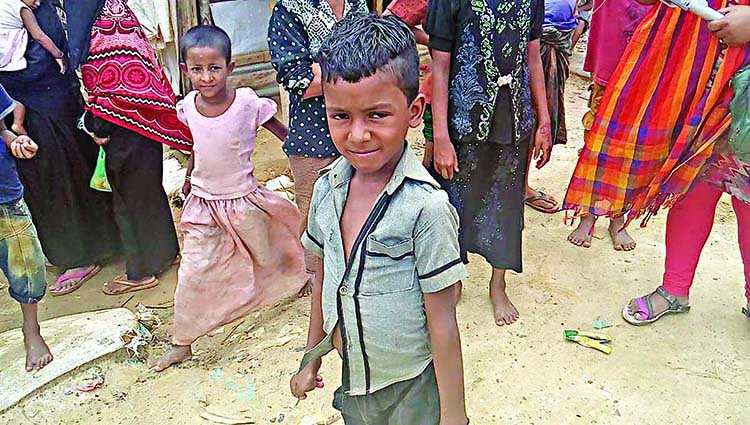
Amputee Saiful Islam, 7, a displaced Rohingya boy living in the world’s largest refugee camp at Kutupalong in Ukhia of Cox’s Bazar, nurtures a dream of growing up to be a physician.Saiful suffered through severe trauma after losing his left leg due to bullet injuries suffered in Myanmar, reports UNB.
Two years ago, five-year-old Saiful along with his father went to a market near their home in the north of the state of Rakhine in Myanmar. On their way back, they came under gunfire. Saiful survived the attack, sustaining bullet injuries to his leg. His father was killed.
A traumatized Saiful along with his mother -Ayesha Begum, then aged 21, and two younger sisters Hosne Ara and Minara Begum who were 5 and 4 respectively — entered Bangladesh fleeing the persecution in Rakhine state of Myanmar just eight days after he was shot.
Saiful’s run of bad luck continued as he was injured once again when a car hit the same left leg around a year into his stay as a refugee in Cox’s Bazar. This time, it forced the amputation of the lower part of his leg.Ayesha Begum said she entered Bangladesh with what was left of her family – i.e. her children along with her parents and brothers.
She was greatly relieved when she learned that under a program run by the International Committee of the Red Cross (ICRC), Saiful qualified for prosthesis, an artificial device that replaces a missing body part, intended to restore the normal functions of the missing body part. An artificial limb, in other words.
Saiful, a class-II student in one of the NGO-run schools in the camp is grateful for being able to walk again. So much so that he now wants to be a doctor when he grows up, since it is thanks to them that he can walk again. Although not quite back to normal life yet, Saiful can now even kick a football around again, slowly and carefully.
Since getting her own leg replaced, Saiful’s fellow amputee Jannat , a girl who is also 7, accompanies him on walks along the winding, hilly roads inside the Kutupalong camp, that according to UNHCR has grown to become the largest refugee settlement in the world with more than 600,000 people living in an area of just 13 square kilometers.They testify to the overriding primacy of life, of surviving, even when all else seems lost, and hopes and dreams hardly seem to count for much.
Another beneficiary of the ICRC program is Alam, who is much older than either Saiful or Jannat, and in fact lost both legs from the knee downwards after stepping on a landmine in 1991. But it was not until the crackdown in 2017 that he fled here along with his family. In August 2017, he entered Bangladesh after crawling for three days.
At the camp, he managed to qualify for the ICRC program to get artificial legs installed, and since then he has been able to even do his bit to support his family.
Alam, father of two sons and a daughter, now operates the sewing machine at a tailoring shop in the camp, earning Tk 200-250 a day. His artificial legs prove handy in winding the machine.
ICRC spokesperson (Public Relation Officer) Rayhan Sultana Toma told UNB that her organization has been working to provide artificial organs and devices in different Rohingya camps and tents in Cox’s Bazar for the last one year.

They came forward to arrange artificial legs for Saiful, Jannat and Alam so that they can return to living normal lives again, or as close to normal as feasible, anyway.
To that end, the ICRC has till now arranged artificial legs and hands, or other such devices, for 113 Rohingya amputees living in the camps in Bangladesh.

